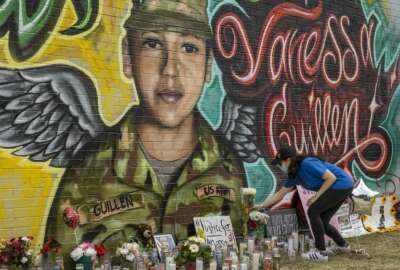
Austin orders new steps to curb sexual assault while panel studies the problem
Defense Secretary Lloyd Austin is telling the military services to stand up new violence prevention workforces, identify "high risk" bases and assess their own...
The DoD Reporter’s Notebook is a weekly summary of personnel, acquisition, technology and management stories that may have fallen below your radar during the past week, but are nonetheless important. It’s compiled and published each Monday by Federal News Network DoD reporters Jared Serbu and Scott Maucione.
Defense Secretary Lloyd Austin has ordered a series of short-and-medium term steps meant to curb sexual assault and harassment, a problem he described in a memorandum to DoD leaders on Friday as “persistent and corrosive” across the military services.
Some of the department’s newest responses are yet to be determined, and they’ll be based on the recommendations of a previously-announced 90-day commission, which also began taking shape on Friday. But in the meantime, the secretary is ordering several interim measures to fight the problem.
For one, each of the services will need to create new workforces dedicated to violence prevention. The memo, which terms the new cadre a “violence prevention community of practice,” offers no specifics on how large the workforce should be, but mandates that at least half of it be trained by the end of this calendar year, with the full workforce trained by the end of June 2022.
“The Secretaries of the military departments will identify and resource personnel whose duties are dedicated to the prevention of interpersonal violence and self-harm,” Austin wrote, while also ordering each department to deliver a report by the end of this fiscal year “describing the constellation and distribution of their prevention workforce, planned resourcing and sustainment, and required staffing changes at all levels.”
But it’s possible that the new workforce will be concentrated on installations and in units where sexual assault and harassment happen at above-average rates — and Austin wants to know which ones those are.
Friday’s directive also orders the undersecretary of Defense for personnel and readiness to send him a report on “high risk” installations “as soon as feasible.” After that, Austin wants to see quarterly command climate survey data from each of those installations, including which ones are “of greatest concern” and which are “showing promise.”
Meanwhile, Austin also wants answers on what the services are doing to comply with the initiatives DoD and Congress have already ordered in recent years to stop sexual assault and harassment. Each of the services has 120 days to report back on their own compliance with existing policies and what they’re going to do to fix any gaps they’ve found.
Also on Friday, the secretary named Lynn Rosenthal, a former White House advisor on violence against women, to lead DoD’s 90 day Independent Review Commission (IRC) on sexual assault and harassment. The Pentagon is expected to sign a formal charter standing up the panel and assigning DoD staff to support it by the end of this week.
The IRC will have three main lines of effort: “Accountability,” “Prevention,” and “Climate and Culture.”
The “accountability” task is meant to deal mainly with how DoD investigates and prosecutes sexual offenses via the Uniform Code of Military Justice. And based on the language of Austin’s tasking, the secretary does not appear inclined at the moment to remove those offenses from the UCMJ system.
Instead, the memo tells the IRC they should look for ways to improve the handling of sexual assault under the UCMJ, as well as the “feasibility, opportunities, and risks from changes to the commander’s role in prosecution.”
But Rosenthal said all options, including moving sexual offenses outside the chain of command, would be on the table.
“I think that accountability is critical. I also believe that these pillars intersect with each other, so without a clear pathway for accountability, the work we want to do on prevention will be completely undermined. And by the same token, we could address that one issue of the chain of command, and if we don’t do all the other things, that’s not going to work either,” she told reporters Friday. “We’re going to look with an open mind and diverse views on this question of the chain of command.” —JS
Congress may take sexual assault prosecution out of chain of command
Sexual assault was once again a banner issue in the military this past year, and it may finally lead to changes in how the problem is handled in the chain of command.
Two of the top lawmakers overseeing military personnel say they are seriously considering using an independent prosecutor to handle sex crimes rather than keeping them in the chain of command.
“Taking sexual assault prosecutions out of the chain of command will be considered by the committee,” Senate Armed Services Committee Chairman Jack Reed (D-R.I.) said. “That has been a proposal going back many, many years. I hope and I expect that in this commission that the defense secretary will ask that issue be raised. I think the idea of separation is once again on the table. We’ll move forward with the notion that, you know, it has to be justified and lead to success.”
House Armed Services Military Personnel Subcommittee Chairwoman Jackie Speier (D-Calif.) told Federal News Network she fully supports changing how sexual assault is prosecuted in the services.
Speier worked on a provision in the 2021 National Defense Authorization Act that would have made the change, however, it did not make it into the final bill.
The most recent numbers show a 3% increase in reported sexual assaults from 2018 to 2019, totaling more than 6,200 incidents. DoD estimates that 40% of assaults aren’t even reported, however.
“Sexual assault is antithetical to the American military. We’re going to be very serious about this,” Reed said.
Protect Our Defenders President Don Christensen told Federal News Network last year how the change in prosecutions would work.
“In the regular justice system a victim would go to the police, the police would investigate, that investigation would be turned over to a prosecutor, and they would make the decision based on the laws and facts whether or not to pursue that case,” he said.
In the military, the service does the investigation.
“The investigation is turned over to a commander who knows the accused,” Christensen said. “The commander makes the decision whether or not to go forward. Then the higher-up commander will make the decision if it goes to trial. None of those commanders are attorneys. They might be a pilot, an artillery officer or a surface warfare officer and they are making very complex legal decisions.” — SM
Women troops paying more out-of-pocket for military-related clothing, study says
A new report from the government’s watchdog says there’s another barrier for women serving in the military at a time when the Defense Department is trying to recruit and retain more females: Uniform cost.
The Government Accountability Office study found that women are paying extra fees based on their sex to the tune of hundreds of dollars.
Every year the military gives enlisted service members an allowance to replace items initially issued to them. However, some items are excluded from that allowance. The Army does not provide funds for an all-weather coat, while the Marine Crops and Air Force do.
“We found these differences in replacement allowances can also contribute to differences in out-of-pocket costs by service and gender for enlisted service members,” the authors of the GAO report state.
The gap between items excluded from reimbursement was at least double in the Navy, Marine Corps and Air Force.
The Army issues 15 pieces of clothing for both genders that are not reimbursable. However, the cost of eventually replacing those items for women is $642.16, while the cost for men is $382.19.
For the Navy, seven pieces of clothing are not eligible for reimbursement and total $353.39, while men have six pieces of clothing excluded totaling $181.57.
The bigger disparities are in the Marine Corps and Air Force. In the Marines, women have three pieces of clothing totaling $266.67 that are excluded, while men only have one at the cost of $89.45. The Air Force has six pieces of clothing for women that do not work with the allowance, which sums up to $411.52, while men have five pieces at $132.87.
“The varying reimbursement rates across the services and the lower reimbursement rates for female enlisted service members were due, in part, to determinations by the services as to which items are not uniquely military,” the authors wrote. “Of the initial provision of clothing items, female enlisted service members may be provided with a one-time cash allowance to purchase items such as underwear, bras, and stockings. This allowance on average ranged from about $125 to $207 across the services from fiscal year 2015 through fiscal year 2020. However, female service members do not subsequently receive an annual replacement allowance for those items and, after the initial cash allowance has been expended, they would pay out-of-pocket to replace them because the services have determined these items are not uniquely military.”
Other items, which are required by the military, but do not get reimbursed, include handbags, swimsuits and dress pumps.
There are a few items like underwear, undershirts and athletic socks, which fall under the same rules for men.
“The lack of consistent criteria across DoD for determining what items may be excluded from the services’ calculations of their standard cash clothing replacement allowances and the resulting variances in out-of-pocket costs for enlisted service members may result in inequitable cash allowances for uniform costs by service and gender,” the GAO analysts wrote.
GAO also found that the military services made 18 uniform changes in the past decade that have disproportionately increased out-of-pocket spending for women. For example, the Navy changed its women’s hat to more closely resemble the men’s hat.
Service members must use their allowance to pay for uniform changes.
GAO is suggesting four actions. One is developing consistent criterial for determining what is or isn’t a uniquely military clothing item. GAO says DoD needs to have regular reviews on clothing replacement allowances to address out-of-pocket cost differences. DoD also needs to make sure the military services submit uniform changes for review with estimated costs. Finally, DoD needs to review military service uniform changes to look for disparities in cost among genders. — SM
Copyright © 2025 Federal News Network. All rights reserved. This website is not intended for users located within the European Economic Area.
Jared Serbu is deputy editor of Federal News Network and reports on the Defense Department’s contracting, legislative, workforce and IT issues.
Follow @jserbuWFED
Scott Maucione is a defense reporter for Federal News Network and reports on human capital, workforce and the Defense Department at-large.
Follow @smaucioneWFED





